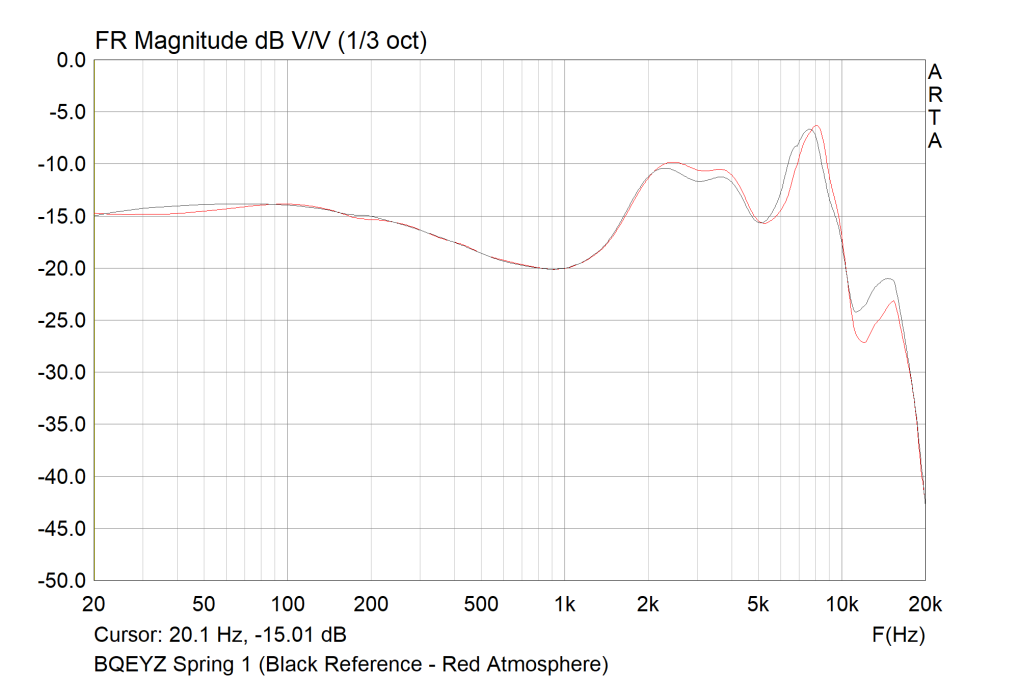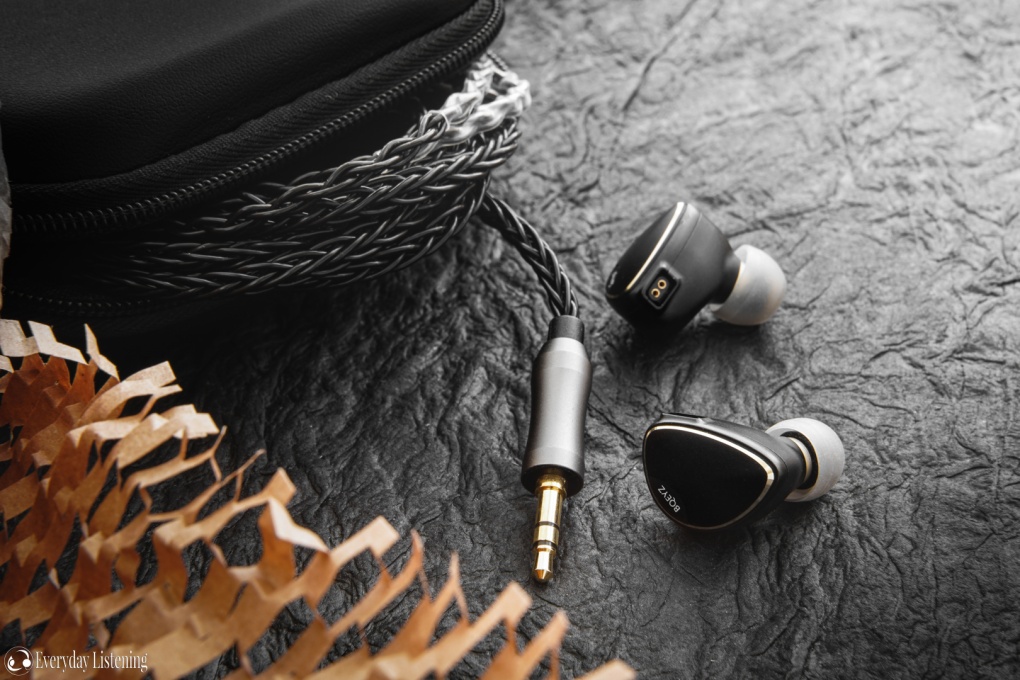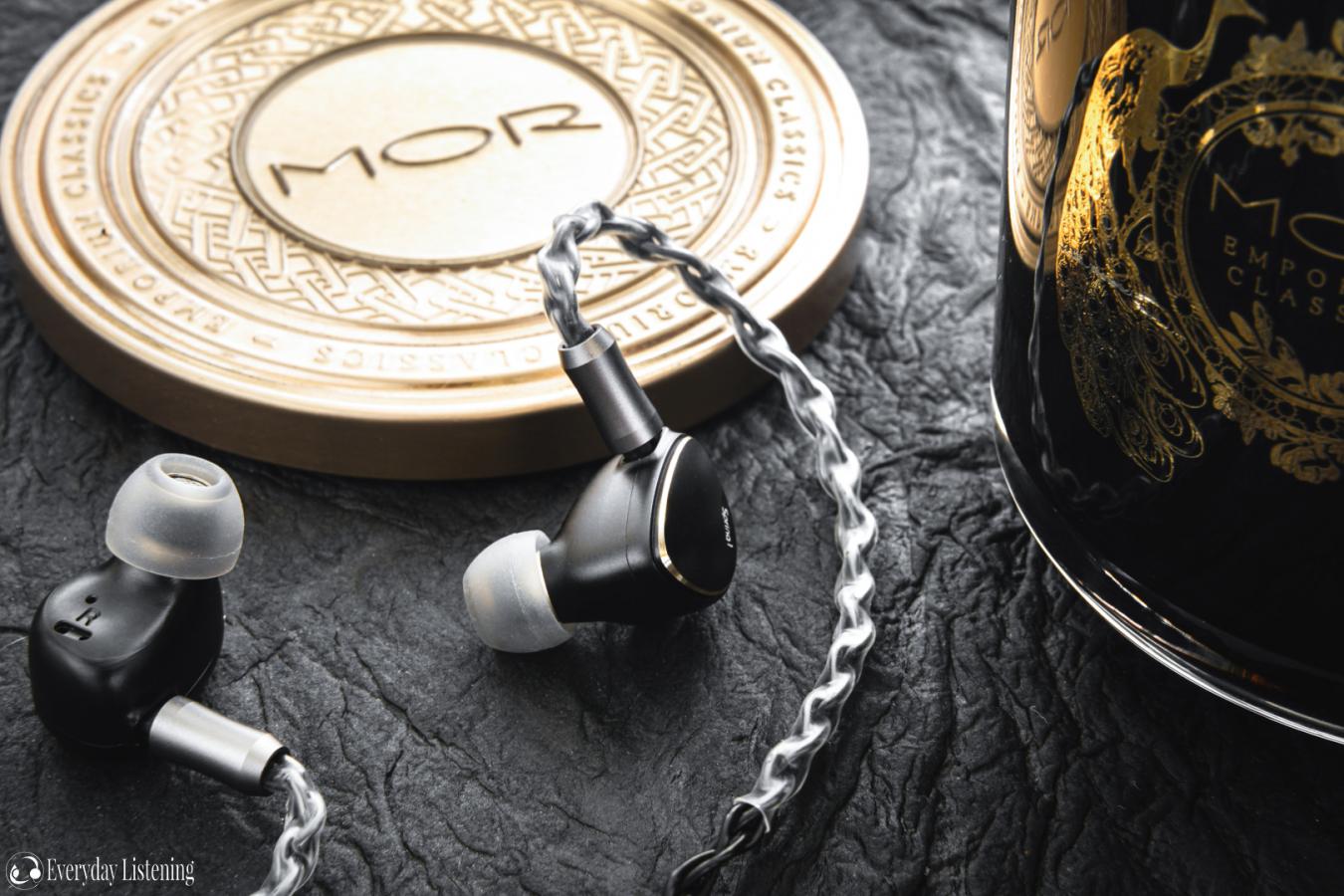Sound –

Testing Methodology: Arta via IEC 711 coupler to Startech external sound card. Note that 7-8KHz peaks are artefacts of my measurement setup. Measurements besides channel balance are volume matched at 1K.
Tonality –
The Spring 1 has what I would describe as a high-end IEM tuning, that being W-shaped, vocal-forward but boosted at the extremities. This is not to say that it performs like a high-end IEM, but it does provide an engaging listen with great contrast while maintaining tri-frequency balance. There’s really solid sub-bass body alongside enhanced mid and upper-bass warmth mitigated by a clean vocal push through the centre midrange. Lower-treble has been attenuated in order to combat sibilance, sharpness and thinness before a reasonable middle-treble peak as I’ve been told, is quite a common resonant point for ceramic drivers. The unique combination of drivers certainly does produce similarly intriguing qualities in real-world listening. This earphone isn’t linear and doesn’t trace any conventional curve but remains a fun and insightful listen.
Tip Selection –
The Spring 1 comes with a delightful metal tip selector with three tuning choices, reference for human voices, atmosphere for bass and foam for max isolation. In listening, I found the reference tips most desirable to my ear, both of the options from BQEYZ and third party. They provided the most balanced sound while the atmosphere tips provided a more bass focussed sound with even thinner treble and more laid-back vocals. Take my measurements above with a grain of salt, in reality, the tips also affect the fit depth and seal which can have a profound impact on the sound perceived by the listener. The foam tips were an acceptable compromise but overly attenuated the highs for my liking. The following comments will be using the reference tips.
Bass –
Colour me impressed, if you’re looking for power, depth and definition, the low end on the Spring 1 delivers – it’s clear this isn’t a generic dynamic driver implantation and the company has considered the acoustics around it. The low-end is on the more diffuse over coherent side due to a notable sub-bass focus and comparatively reduced mid-bass body. Regardless, this is for good reason as sub-bass has terrific extension, tightness and pressure, delivering visceral slam and defined rumble. Meanwhile, mid and upper-bass are both moderately enhanced just to a lesser degree, and demonstrate good linearity, producing a low-end with thick, bold notes while avoiding excessive warmth or tubbiness.
Driver quality is a high point for the Spring 1, with excellent driver control, keen attack and natural decay providing a handsome balance between pace and dynamics. The earphone’s driver control, in particular, goes far to rein in its bold notes, minimising the smearing of fine details and upholding as much separation as one would hope for given this level of fullness. This isn’t a hyper-fast BA low-end nor a perfectly linear and natural one, and it doesn’t retrieve detail as such with heavier and slightly more lingering notes. The Spring 1 rather delivers a powerful, rumbling bass with good technical ability and great dynamics for engagement over accuracy.
Mids –
In accordance with their W-shaped tuning, vocals are clean, clear and slightly smooth in presentation. They hold precedence over instruments within the midrange due to a lower-midrange dip that mitigates bass spill followed by wideband centre midrange emphasis. As there is no upper-midrange bias, vocals are brought forward but retain a reasonably natural tone. Instead, emphasis sustains linearly from 2KHz all the way through to 4KHz. The midrange, therefore, isn’t especially dense nor is it full-bodied, but provides excellent vocal extension in addition to high clarity while sibilance, thinness and sharpness are mitigated by a sharp trough in the lower-treble.

Vocals are, therefore, smoothly articulated with ample body derived from the midrange itself and a hint of euphonic warmth permeating from the upper-bass. Though a slightly more linear transition into the midrange would have yielded a more accurate timbre and note body, these traits work well in harmony; with bolstered vocal body and warmth counterbalancing enhanced vocal size and intimacy. Again, timbre isn’t nearly perfect and note resolution leaves to be desired. However, there are no immediate flaws in its presentation which cannot be said for a lot of budget hybrids. Simply put, the Spring 1’s midrange is well-balanced between male and female in addition to being layered, defined and natural in tone.
Highs –
Though we have a very small number of ceramic tweeter earphones, they all have a distinct sound, being emphasized around the middle-treble region, and providing thin but immaculately clean transients. Though the lowest cost-implementation I’ve heard, many of the same qualities can be observed here. Actually, I was relieved to see a laid-back lower-treble which may smooth off attack but also takes the sharpness and sibilance out of its presentation. To redeem clarity and crispness, there’s a modest peak around 7-8KHz that bolsters both air and detail presence. The background remains fairly clean nonetheless, as quantity diminishes quickly after. As this is a narrow peak, note body is thin though instruments such as cymbals retain nice texture if with somewhat truncated shimmer, while lacking hard-edged percussion due to the earphone’s lower-treble tuning.
What the ceramic driver provides here is immense cleanliness and agility within the foreground which translates to a focussed and resolving presentation. There’s also a touch of warmth in the treble which, in conjunction with excellent detail retrieval, makes this earphone a great choice for acoustic. They also suit rock where their clean transients control any brittle or splashy character. There’s a pleasing amount of air but little upper-treble sparkle and extension so the immaculate and resolving character of high-end ceramic IEMs is not present here. Nonetheless, micro-details are impressively abundant and the background is reasonably well-defined. Though not the most aggressive earphone, the ceramic driver retains a crisp, well-detailed image despite their smoother attack at the expense of distinctly thin note body.
Soundstage –
The Spring 1 provides a reasonably large stage that extends just beyond the head in terms of width and, despite its vocal presentation, is able to project pleasing depth too. As such, it presents a nicely rounded sound. Imaging is sharp if not perfectly coherent or accurate to my ears. Quick, clean treble transients permit sharp directional cues and strong directionality if not perfect precision to panning and transitions. Meanwhile, vocals maintain a strong centre image providing defined and distinct layering. The earphones possess strong separation on behalf of their controlled bass and W-shaped signature that heightens the distinction between each core frequency band in addition to high driver control and note body that generally errs on the slightly thinner side of neutral.
Driveability –
With a higher 43ohm impedance paired with a similarly high 108dB sensitivity, the Spring 1 is reasonably efficient in addition to being impressively agnostic to output impedance. In fact, comparing between my desktop JDS Atom setup with the 10-ohm Hiby R6 yielded very minimal differences to signature beyond the tone of the sources themselves. The Hiby has a touch warmer and smoother up top most notably due to a small difference within the upper-midrange; the Atom being a touch more forward, the Hiby more laid-back. The Spring 1 scales well with a bit of power, especially within the bass where control is noticeably improved alongside associated qualities of definition, detail retrieval and separation. Still, the Spring 1 is very forgiving of the source and a great choice for smartphone listeners due to its efficiency and stable signature.
Comparisons –

Moondrop Starfield ($109): The Moondrop is a legend in its price class, I haven’t seen such unanimous praise for a long time. By comparison, it is more linear and less dynamic with a generally smoother and more coherent voicing. Its low end lacks the same pressure but extends similarly well. The Spring 1 has more bass presence, especially sub-bass, and higher driver control with a lot more bass note definition and separation. The midrange is forward on both, more upper-midrange biased on the Starfield but also denser and more linear in transition from the bass. The Starfield has a slightly more natural voicing and a more accurate timbre as a result, possessing better balance between body, tone and density.
Contrarily, the Spring 1 has more vocal definition but is also less coherent with lower note resolution. The Starfield has a more linear top-end too, the Spring 1 has cleaner transients, more extension and resolution with superior detail retrieval. Meanwhile, the Starfield sounds more natural, its instruments have more body and texture alongside more coherent positioning within its stage. Both have similar soundstage expansion, the Spring 1 has a touch more width and better separation while the Starfield possesses more accurate imaging.
Final Audio E4000 ($140): The E4000 is a more L-shaped earphone with more bass emphasis and a laid-back top-end. The E4000 has more bass quantity overall, it has similar extension but less sub-bass bias, being more linear. As it has more mid and upper-bass presence, it is warmer and slightly fuller where the Spring 1 is cleaner in tone but also less natural sounding. Both have excellent driver control, the Spring 1’s cleaner tuning results in greater separation and definition, it has slightly sharper attack where the E4000 is smoother. The E4000 has more substantial vocals, with greater body and slightly more warmth.
It has similar definition but higher note resolution and better coherence. The E4000 sounds more natural and accurate in timbre while the Spring 1 has better separation and more defined layers. The Spring 1 has a crisper, thinner treble with a cleaner tone and sharper note attack. The E4000 has a warmer treble with a lot more body and greater texture. The E4000 has a darker background while the Spring 1 has better extension with more background detail retrieval and resolution. The E4000 has a slightly larger soundstage with more accurate imaging while the Spring 1 has a lot more separation.
Shozy CP ($170): The CP is another well-balanced offering around this price range, sporting an all BA setup. It has less substantial bass, the Spring 1 has a more quantity and extension, delivering a weightier, fuller presentation. The CP is much quicker decaying with tighter, punchier notes and more definition while the Spring 1 has bolder more naturally decaying notes with greater dynamics. Both have strong vocal presence, the CP is slightly more neutral where the Spring 1 is a touch forward. The CP also transitions more linearly into the midrange, so alongside greater upper-midrange bias, it has more clarity and similar body.
The CP is also a touch warmer from its upper-bass and sounds slightly more natural to my ear. Meanwhile, the Spring 1 has slightly higher vocal definition and separation, I also hear more defined layers especially due to its more resolving top-end. The CP has a small lower treble peak for clarity and energy, it has a crisper and sharper treble. Meanwhile, the Spring 1 is cleaner in its presentation, being less aggressive in the foreground but offering greater extension and slightly better resolution. The Spring 1 has a larger soundstage while the imaging is a bit more stable on the CP.
Hyla CE-5 ($940): Obviously no comparison is to be had regarding price, however, as one of the pioneers of piezoelectric tribrids, I felt it apt. The CE-5 offers slightly less bass quantity with better extension linearity between sub and mid-bass. It has higher driver control with more texture and detail retrieval, the CE-5 has better dynamics and a more natural note presentation. The CE-5 has a more forward midrange with greater upper-midrange bias. Neither are dense actually, the Spring 1 is a bit more natural here while the CE-5 has quite a sharp lower-midrange attenuation that can make it sound a bit thin and dry at times.
The Spring 1 has more body and isn’t quite as forward sounding, both are quite smooth due to lower-treble attenuation. Up top, the CE-5 has a crisper presentation with more aggressive attack. It is brighter overall but also a lot more detailed with higher resolution and stronger extension, even a good amount of sparkle. The Spring 1 has slightly more treble warmth and body, being smoother and more balanced but lacking the same transient cleanliness. The CE-5 provides a larger soundstage, neither have perfectly coherent imaging but the CE-5 has stronger directionality due to its keener treble transients.
Verdict –

To my ears, the hallmark of nailing an outstanding budget earphone is to make the listener forget that they’re listening to a budget earphone, not to convince the listener that they’re listening to a high-end one. In that sense, the market has come far, I’m seeing substantially more natural tonalities and less treble peakiness than before. I also have an ever-increasing repertoire of models where the former comment applies, as seen in my comparisons. The Spring 1 is a curious offering as it treads a fine line down the middle of the two. In terms of technical ability, the Spring 1 will likely fool many listeners, especially with regards to its stringently controlled bass and clean, resolving treble, there’s some proper design going on there. The tuning is also relatively balanced and quite mature if not especially linear or conventional. This earphone, therefore, isn’t for those wanting huge engagement and doesn’t suit those valuing timbre either. Rather, the Spring 1 excels in its careful modulation of both, delivering strong tri-frequency contrast balanced by a tasteful tone and natural midrange voicing.
The Spring 1 is available from on Aliexpress and HiFiGO (International) for $139 USD at the time of writing. I am not affiliated with BQEYZ, Aliexpress or HiFiGO and receive no earnings from purchases through this link.
Track List –
88rising – NIKI Acoustic Sessions
Eagles – Hell Freezes Over
Father John Misty – Pure Comedy
Jeremy Zucker – comethru
Joji – Sanctuary
Lauv – I met you when I was 18
Michael Jackson – XSCAPE
Post Malone – beerbongs & Bentleys
Rich Brian – The Sailor
Sun Rai – Pocket music
The Mamas & Papas – If You Can Believe Your Eyes & Ears
TALA – nothing personal
Yosi Horikawa – Wandering



